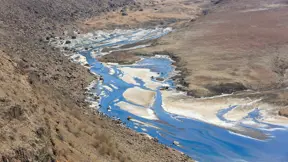
Extending the life of a hydropower plant
Evaluating best practices in managing reservoir sedimentation
The Cameron Highlands is renowned for its fresh agricultural produce. However, rapid development and land clearing in the region have significantly altered its land cover, resulting in increased sediment loads to Ringlet Reservoir. The sediment-laden flows have resulted in greatly reduced storage capacity and consequently led to reduced power generation and flood control, with potential negative impacts on the safety of the dam. With current sediment management practices falling short in addressing the influx of sediment, TNB Research (TNBR)—the research arm of a major Malaysian power utility—needed to devise an effective sediment management strategy.
Challenge
Ringlet Reservoir forms part of the Cameron Highlands Batang Padang hydroelectric scheme that was completed more than 50 years ago. The reservoir is formed by the Sultan Abu Bakar dam, constructed in 1963. Since then, land clearing activities for agricultural and urbanised areas in the upper catchments have mobilised millions of tons of additional sediment into the reservoir. This regrettably accelerated the sedimentation of the reservoir, resulting in a loss of operational volume for hydropower generation. The incoming sediment to the reservoir is estimated to be in the region of 300,000 m3/year, which is about 10 times that of the design sedimentation rate.
TNB has constructed two sediment check dams at the main inlets (Habu and Ringlet ends) to reduce the sediment inflows and maintain the storage capacity of the reservoir. The retained sediments are continuously removed from the check dams while dredging is carried out in the reservoir itself. To better manage these sediments, a robust and sustainable sediment management plan is required to be drafted and implemented. Thus, DHI carried out an extensive study to quantify the complex morphological changes in the reservoir and evaluate the effectiveness of a range of sediment management practices.
Solution
DHI conducted a comprehensive sedimentation study to address the challenges at Ringlet Reservoir. We utilised advanced hydrodynamic and morphological modelling tools, specifically the MIKE 21 Hydrodynamics Flow Model (HD FM) and the MIKE 21 Mud Transport (MT) module to predict sedimentation rates, estimate the volume of sediment accumulation and determine the necessary maintenance dredging. We also simulated changes in bed thickness and sediment accumulation behind check dams to develop an effective sediment management strategy.
The numerical modelling of the reservoir serves as the primary tool to assess the sedimentation issues and to investigate various mitigation solutions. These require substantial amounts of data and to be supported by a dedicated site survey campaign. Given the rapid pace of development in the catchment, the hydrodynamic and sediment transport models are challenging to calibrate. The sediment input into the model is supplemented by DHI’s in-house equipment, which proved to be successful in estimating the particle size distributions at various locations within the tributaries and the reservoir body.
Besides appraising the impact of land clearing on the sedimentation rates, we have also provided the following services:
- Evaluation of current best practices in reservoir sediment management
- Review of the current dredging and desilting operations
- Numerical modelling to provide a platform to assess the current sediment loading and test the practicality of various mitigation and management options
- Development of a sustainable sediment management plan for Ringlet Reservoir
In total, eight different mitigation options were developed based on improving the retention performance in the upper parts of the reservoirs, increasing the reservoir flushing and introducing sediment bypass tunnel.
Results
The improvement in sediment management oversees a reduction of reservoir deposition of between 14% and 54% over the baseline conditions. The established sediment management strategies ensure that the long-term resilience of this critical infrastructure facility is safeguarded.
- Ability to test a range of reservoir sedimentation management practices
- More robust and efficient decision-making driven by numerical modelling
- Easier access to validated data for making risk-based and infrastructure-specific decisions
Client:
TNB Research Sdn. Bhd
Location:
Malaysia
Related SDG(s):
SDG 7: Ensure access to affordable, reliable, sustainable and modern energy for all
Technology:
About our client
TNB Research Sdn. Bhd (TNBR) is the research arm of a large power utility company Tenaga Nasional Berhad (TNB) in Malaysia. Its mission is to enhance stakeholders' interest through its commitment to pioneer and develop technical solutions and innovation under various applied research projects.
You may also like
How can we help?
With our global network of offices, we make sure you get the right answers to your local needs. Tell us about your water challenges and we will get back to you.




